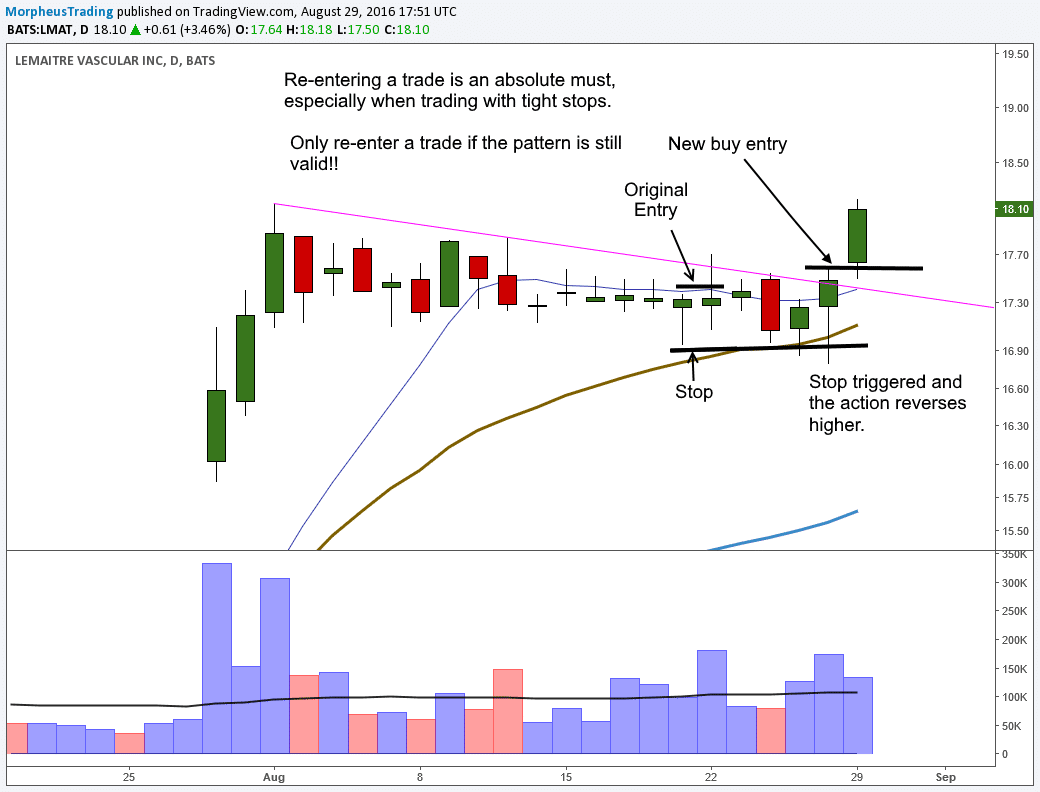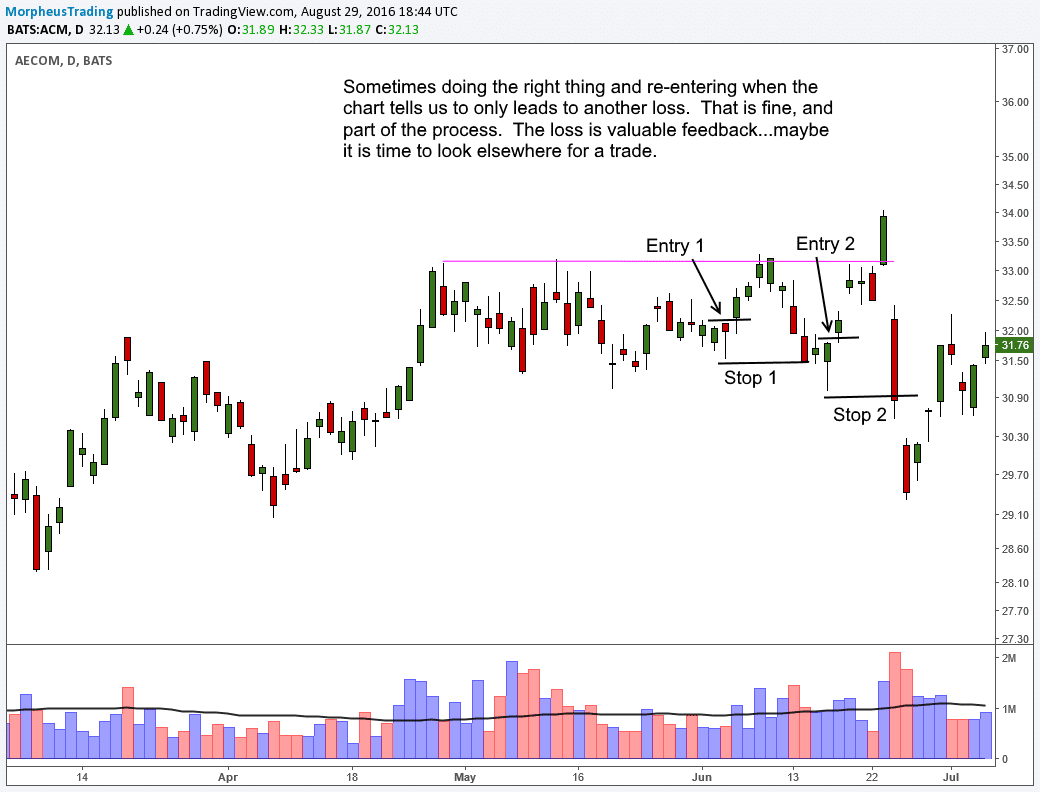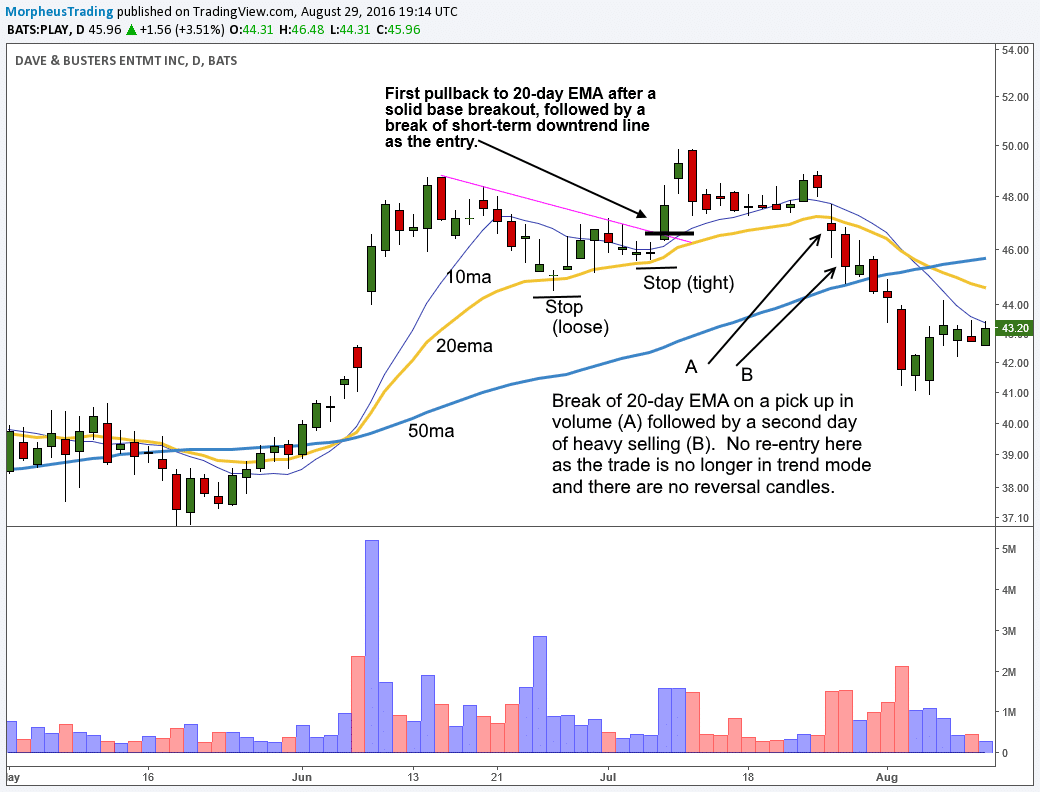
You identify an ideal buy point on a stock chart and enter a new swing trade with little to no hesitation.
But as soon as you’ve entered the position, the price falls apart and forces you out of the trade when your protective stop is triggered.
Then, as soon as you’re out of the trade, the stock swiftly reverses back up.
After running 5% to 10% higher over the next few days, you’re left in the dust with no position and tear in your beer!
Sound familiar?
If so, continue reading this article to discover an excellent technique and tips to psychologically help you exit losing trades the right way and feel great about doing so.
Understanding The Psychology Of Stopping Out
If you have been burned in the past by exiting a trade at the worst possible time, it may be psychologically challenging to deal with stopping out of a position.
Depending on your individual psyche, getting stopped out and missing a big rally may cause you a great deal of emotional pain.
To avoid this pain, you could choose to ignore your predetermined stop and hope for the price to quickly rebound instead.
“It always bounces back,” you say of the stock’s historical price action.
 But as the school of hard knocks teaches, that one time you decide to ignore the stop will eventually be when the stock price tumbles 10% to 20% lower, rather than promptly rebounding.
But as the school of hard knocks teaches, that one time you decide to ignore the stop will eventually be when the stock price tumbles 10% to 20% lower, rather than promptly rebounding.
Can you relate to this vicious cycle?
After learning the hard way many years ago, I finally realized that stopping out of a losing trade does not need to be painful.
Nor does it need to put you in a negative state of mind.
If you can identify with the above, be sure to read this insightful post all the way to the end because there is hope!
Next, I will share 3 different annotated trade examples that got stopped out, followed by my 7 Top Tips For Managing Stopouts at the end of article.
1. When To Stop Out & Re-enter ($LMAT)
My first example is a stock trade that actually should be re-entered after the original stop price is triggered.
The annotated daily chart of $LMAT below tells the story:

Summarizing the chart above, the original buy entry into $LMAT shares was on August 22 (triggered by a rally above the prior day’s high).
Since a bullish reversal candlestick formed on August 19, placement of the original stop was below that session’s intraday low.
A few days later (August 26), the price dipped below the August 19 low and triggered the stop before reversing 4% higher.
It’s easy to see how such a swift bullish reversal could have sent many traders into a negative mind set after getting stopped out.
If it happened to you, perhaps you would even think about how you could have placed the stop a bit lower using some new technique.
But the answer is not a new technique because all stop placement strategies will eventually work (or fail) as well.
Do not focus on preventing the stop out.
Instead of trying to avoid getting stopped out, focus on what type of subsequent price action would force you back into the trade.
To be clear, I am NOT talking about revenge trading, where you simply re-enter a losing trade at random to show the stock “who is boss.”

Instead, use the chart to objectively tell you when to get back in.
Doing so should reduce the anxiety and pain that can be associated with stopping out, while also increasing your odds of a profitable trade on the second attempt.
In the case of $LMAT, the August 26 reversal was a bullish sign, and the bullish pattern of consolidation was still very much intact.
You could have re-entered at the August 26 close, in anticipation of follow-through the next day, OR simply waited for the stock to flash a valid buy trigger by rallying above that day’s high in the following session (with new stop below that day’s low).
In the model portfolio of The Wagner Daily newsletter, we actually entered $LMAT at $17.56 on August 22.
However, we narrowly escaped getting stopped out because our stop was placed well below the 20-day exponential moving average (to give the setup some “wiggle room”).
Nevertheless, although we did not stop out of $LMAT (which is now showing an unrealized gain since entry), we have certainly had plenty of stopouts at Morpheus Trading over the past 14 years.
$LMAT is a solid example of when it makes sense to re-enter a trade you stopped out of.
2. When To Walk Away ($ACM)
Sometimes you properly re-enter a trade (as described in #1 above), but still suffer a loss the second time around.
On the daily chart of $ACM below, this is what happened:

Notice the first stopout occurred on June 14, which was followed by a bullish reversal on June 16.
The bullish reversal formed a hammer candlestick pattern that day, which meant the trade could have been re-entered at the close, OR on the next day’s open (above prior day’s high).
Although the stock triggered a valid re-entry, $ACM failed to hold above its breakout level (over $33) and fell apart quickly.
After stopping out the second time, the price action had become too volatile and was forming “lower lows” below $31.
After back-to-back stopouts on the same stock, it is usually best to just walk away, especially when the original bullish pattern is no longer valid in the near-term.
3. When To Let It Be ($PLAY)
Finally, let’s look at a stock chart that shows a stopout, but no valid reason to re-enter the trade after the initial exit.
The daily chart of $PLAY below shows a pullback entry off the rising 20-day exponential moving average (within a strong uptrend):

Although it was a pullback entry, the retracement was too steep and the price eventually broke below both the 20 and 50-day moving averages.
When the price broke down, both stops were triggered, but notice that subsequent price action simply provided no ideal place to re-enter the trade.
Specifically, the breakdown below the 20-day exponential moving average suggested the stock is no longer in “trend mode.”
The break below the 50-day moving average means there could be at least several more weeks of chop until another proper buy setup forms.
In this case, just forget about the trade and move on to the next potential opportunity on your stock watchlist.
7 Top Tips For Managing Stopouts:
- Obey the mental or physical stop. You can be a bit flexible here, but don’t let a 5% stop turn into 10% loss.

- Do not focus on why the stop was hit. The reason is irrelevant, so don’t waste your mental energy.
- Monitor the price action for a bullish signal of potential re-entry after stopping out. Learn about candlestick patterns such as hammers, gap down reversal, or bullish engulfing candle.
- Bullish reversals described in #3 should arrive no more than a few days later (not two weeks later).
- If a re-entry buy signal develops, determine if the overall chart pattern is still intact. If so, re-enter the position on strength the very next day, with a stop beneath the low of the prior day’s reversal candlestick.
- The price may run higher before there is a clear entry, but do not re-enter until the reversal looks like it will hold up intraday. Do not revenge trade by trying to “catch a bottom” near the lows of the session.
- If the re-entry fails, then it may be best to walk away from the setup. Do not attempt to trade the same pattern (in same stock) three to four times over a short period of time.
Locked and Loaded
With the examples and tips above, you are now armed with an effective methodology for managing your trades that get stopped out.
Once you learn to keep your emotions in check, and know what to look for on the charts, re-entering a trade should be fairly easy.
No technique works 100% of the time, so you should expect that any given stock will eventually rip higher without producing a single re-entry point.
But don’t be discouraged by this; just continue to follow the rules above and you will come out ahead in the long run.
Sign up now for your trial subscription to our nightly stock pick newsletter and learn more about how we proactively manage swing trades.
Whether you enjoyed this article OR thought it sucked, please share it and drop us a comment below. We love hearing from fellow traders!
Cheers,
Deron
